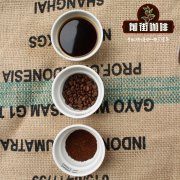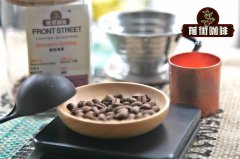Analysis of coffee flavor IV: coffee origin and flavor coffee types and taste sweetness

Professional coffee knowledge exchange more coffee bean information please follow the coffee workshop (Wechat official account cafe_style)
The coffee we drink every day is mainly Arabica or Robusta, that is, soluble coffee is mainly Robusta, and high-quality coffee is Arabica. The coffee we drink every day is a mixture of two kinds of coffee beans and coffee. In addition, Arabica also has many subspecies, each with its own flavor. For example, Pacamara and Geisha, which have performed very well in COE in recent years, are counted as a kind of Arabica.
The main types of coffee available in the market are Arabica or Robusta, which have their own characteristics as well as their advantages and disadvantages.
Arabica
The producing countries are mainly Latin American countries, with a balanced and mellow taste and low caffeine content, most of which are only 1-1.3%. Different manors can create a variety of flavors under different planting conditions, so boutique coffee comes from this variety. However, because the planting environment is stringent, such as the environment with high altitude and large temperature difference, sufficient moisture, long ripening time, lower yield than other varieties, and easy to suffer from leaf rust, most subspecies can not be exposed to sunlight directly, so the cost of production remains high.
There are two ancient native species of Arabica, Typica and Bourbon.
Typica is a native variety of coffee, originated in Ethiopia, and all Arabica species are derived from Typica.
The parietal leaves of Typica are bronzed and most of the beans are oval or thin-pointed. His flavor is elegant, but his physique and disease resistance are poor, so his output is not much. Jamaica Blue Mountain, Sumatra Manning and Hawaii Kona are all derived from this bean seed.
Bourbon
Most people believe that it is a natural variety of Typica transplanted to Yemen, and the bean body is relatively round. In 1715, France got its name from the transplantation of this variety from Yemen to the island of Bourbon on the east coast of Africa.
After years of cultivation, in addition to these two native species, more subspecies have multiplied.
Bourbon Pointu
Found in Bourbon in 1810, it is a variety of Bourbon. The shape of the bean has changed from round to pointed, and its caffeine content is only half that of ordinary Bourbon. It is extremely precious because it is weak and low in yield. Now most of it is only cultivated in the laboratory.
Caturra
The special variety of Bourbon gene found in Brazil in 1950s has a similar flavor to Bourbon and has sour taste of lemon or citrus but less sweetness than the original variety. Although the production capacity is high, disease resistance is good, and shade trees are not needed, sweetness is directly related to the amount of fertilizer applied, and continuous fertilization and pruning are needed, so the operating cost is high, coupled with the two-year harvest time, the actual yield is still not high.
Pacas
A special variant of Bourbon gene was discovered by Salvadoran coffee farmer Pacas in 1935. Coffee farmer Pacas found that the output of coffee trees in the middle of the village was higher than that of others, so he asked experts to identify it and found it.
SL28 and SL34
At the beginning of the 20th century, Bourbon, which was screened and cultivated by French and British missionaries and researchers in Kenya, tastes sour and fragrant. After a hundred years of cultivation, this variety has adapted to Kenya's high-phosphate soil, and all the top Kenyan coffee comes from these two varieties. But once they are transplanted to other places to grow, the taste will lose its original characteristics.
Because the geographical conditions, bean varieties and climate of different countries are different, each producing area has its own unique flavor.
Baya: the taste is mild, the acidity is moderate and the aroma is soft. Columbia: the aroma is rich and unique. Jamaica: sweet in acid and good in flavor. Ethiopia: fragrant and sour, excellent mellow. Indonesia: bitter and thick, bitter and heavy.
Hawaii: bright sour fruit, mellow, soft and smooth. Guatemala: mild acidity and obvious sweetness.
Important Notice :
前街咖啡 FrontStreet Coffee has moved to new addredd:
FrontStreet Coffee Address: 315,Donghua East Road,GuangZhou
Tel:020 38364473
- Prev

Coffee flavor analysis three: a variety of coffee flavors to understand the flavor of coffee before and after the paragraph
Professional coffee knowledge exchange More coffee bean information Please pay attention to coffee workshop (Weixin Official Accounts cafe_style) to discuss the extraction of various flavors in hand-brewed products, and see how to systematically present the best flavor of single-item coffee by using personal brewing techniques. In the extraction process, besides concentration is one of the variables, flavor also changes with the length of extraction time.
- Next

Sensory Identification of Coffee: about Coffee Flavor training methods Coffee sensory Identification
Professional coffee knowledge exchange more coffee bean information please follow the coffee workshop (Wechat official account cafe_style) boutique coffee industry symbol of the American boutique Coffee Association (SCAA), the design of the coffee flavor wheel (Coffee Tasters Flavor Wheel) completed the first update in 21 years at the beginning of this year. The revision of the new flavor wheel makes full reference to the world.
Related
- Beginners will see the "Coffee pull flower" guide!
- What is the difference between ice blog purified milk and ordinary milk coffee?
- Why is the Philippines the largest producer of crops in Liberia?
- For coffee extraction, should the fine powder be retained?
- How does extracted espresso fill pressed powder? How much strength does it take to press the powder?
- How to make jasmine cold extract coffee? Is the jasmine + latte good?
- Will this little toy really make the coffee taste better? How does Lily Drip affect coffee extraction?
- Will the action of slapping the filter cup also affect coffee extraction?
- What's the difference between powder-to-water ratio and powder-to-liquid ratio?
- What is the Ethiopian local species? What does it have to do with Heirloom native species?

